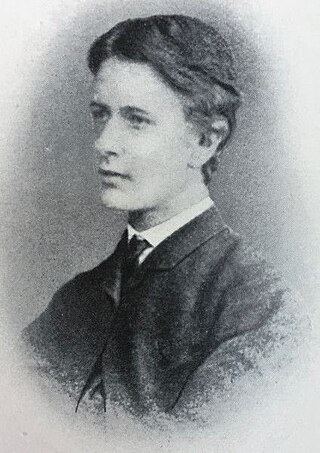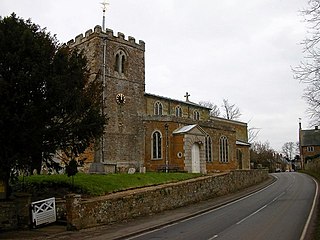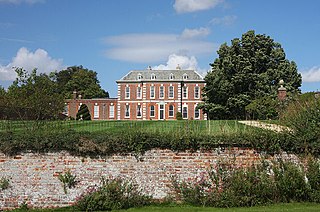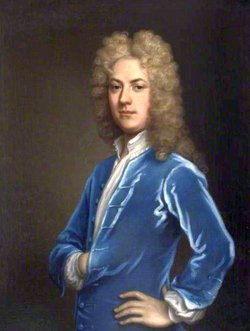
Finedon Hall is a Victorian country house in Finedon, Northamptonshire. It is a Grade II listed building. [1]

Finedon Hall is a Victorian country house in Finedon, Northamptonshire. It is a Grade II listed building. [1]
The core of the house is 17th or 18th century, and was extensively remodelled by William Harcourt Isham Mackworth Dolben (1806–1872). Datestones indicate a range of different building phases: 1855, 1851, 1856 and 1859. The architect is unknown, but is likely to have been E. F. Law of Northampton. [1] Mackworth Dolben was himself an 'enthusiastic' amateur architect. [2] There is also a range of fine ancillary buildings: the Museum Tower, the Bell Tower and the Old Chapel, also listed Grade II. The estate was landscaped with advice from Humphry Repton. [3] Until its dramatic collapse in 1951, the estate was home to the well-known monument, the Volta Tower. [4] [5]

From the early 15th to the 18th century, the manor was in the hands of the Mulso family. [6] On the death of the last of the Mulso line, Tanfield Mulso, Finedon passed to his daughter, Anne. [6] She married Sir Gilbert Dolben, 1st Baronet, and the house remained in the Dolben family until the death of the last baronet, Sir John English Dolben, in 1837. [6] It then passed to his daughter, Frances. [6] She married William Harcourt Isham Mackworth (1806–1872), a younger son of Sir Digby Mackworth, 3rd Baronet, who took the name of Dolben. Both his heirs were drowned; the elder son William Digby Mackworth Dolben died whilst serving aboard HMS Volta in 1863 and the younger, the noted poet Digby Mackworth Dolben, died aged seventeen while swimming in the River Welland, near South Luffenham in Rutland in 1867. [2] The estate passed to their sister, Ellen, after whose death in 1912 it was divided and sold.
From 1936 the hall was used by the Free French as a rehabilitation centre for allied troops, and was visited on at least one occasion by Charles de Gaulle. [7] The facility was run by Col. Pierre Mallinger, who subsequently bought the hall and used it as a centre to conduct research into tropical diseases. [7] After Mallinger's death in 1971 the hall was sold to Geoffrey St Clair Wade. St Clair Wade's scheme for developing Finedon was not realised, and by the time of his death, the condition of the house had become parlous. [8] The hall was saved, in part, due to the efforts of the Ancient Monuments Society. [9] The house has now been converted into apartments. [10]
John Dolben, of Epsom, Surrey, was an English barrister and Whig politician who sat in the House of Commons from 1707 to 1710. He was deeply involved in the impeachment proceedings against Dr Henry Sacheverell in 1710, and his work on the impeachment is said to have contributed to his early demise.

Lamport Hall in Lamport, Northamptonshire is a fine example of a Grade I Listed House. It was developed from a Tudor Manor but is now notable for its classical frontage. The Hall contains an outstanding collection of books, paintings and furniture. The building includes The High Room with a magnificent ceiling by William Smith. It also has a library with 16th-century volumes and an early 19th-century cabinet room with Neapolitan cabinets which depict mythological paintings on glass. It is open to the public.

Digby Augustus Stewart Mackworth Dolben was an English poet who died young from drowning. He owes his poetic reputation to his cousin, Robert Bridges, poet laureate from 1913 to 1930, who edited a partial edition of his verse, Poems, in 1911.

Lamport is a village and civil parish in West Northamptonshire, England. The village is on the A508, about 8 miles (13 km) south of Market Harborough and 8 miles (13 km) north of Northampton. Nearby is Lamport Hall. At the time of the 2001 census, the parish's population was 207 people, including Hanging Houghton and increasing to 225 at the 2011 Census.

Finedon is a town in North Northamptonshire, England, with a population at the 2011 census of 4,309 people. In 1086 when the Domesday Book was completed, Finedon was a large royal manor, previously held by Queen Edith, wife of Edward the Confessor. From the 1860s the parish was much excavated for its iron ore, which lay underneath a layer of limestone and was quarried over the course of 100 years or more. Local furnaces produced pig iron and later the quarries supplied ore for the steel works at Corby. A disused quarry face in the south of the parish is a geological SSSI.

Great Harrowden is a village and civil parish in North Northamptonshire, with a population at the 2011 census of 161. The village sits astride the busy A509 running between Kettering and Wellingborough - although a bypass is due to be built shortly. The village forms part of the Orlingbury hundred.
William Digby, 5th Baron Digby was a British peer and Member of Parliament.

Gilbert Affleck, of Dalham Hall, Suffolk, was a British Tory politician who sat in the House of Commons between 1722 and 1741.
There have been two baronetcies created for persons with the surname Mackworth, one in the Baronetage of England and one in the Baronetage of Great Britain. One creation is extant as of 2008.

The Isham Baronetcy, of Lamport in the County of Northampton, is a title in the Baronetage of England.
Volta Tower was a folly in the town of Finedon, Northamptonshire, England. It was built in 1865 and collapsed in 1951.

The Dolben Baronetcy, of Finedon in the County of Northamptonshire, was a title in the Baronetage of England. It was created on 1 April 1704 for Gilbert Dolben, son of John Dolben, Archbishop of York. Gilbert was judge of the Court of Common Pleas (Ireland) and MP for Ripon, Peterborough and Yarmouth, Isle of Wight. The 3rd Baronet was an MP for Oxford University and Northamptonshire, and was an avid campaigner for abolition of the slave trade. The title became extinct on the death of Sir John English Dolben, the 4th Baronet, in 1837. William Harcourt Isham Mackworth (1806–1872), a younger son of Sir Digby Mackworth, the 3rd Baronet, took the additional surname Dolben after he married Frances, the heiress of the 4th Baronet.

Sir William Dolben, 3rd Baronet (1727–1814) was a British Tory MP and a zealous campaigner for the abolition of slavery.

Normanton Hall was a large, now demolished, country house at Normanton in Rutland.
Herbert Mackworth was a Welsh landowner, coal owner and Tory politician who sat in the House of Commons from 1739 to 1765.

Sir Justinian Isham, 4th Baronet was an English landowner and Tory politician, who sat in the House of Commons almost continuously from 1685 until his death in 1730. He was the longest serving member, later termed Father of the House, from 1729 to 1730.

Sir Justinian Isham, 5th Baronet, of Lamport, Northamptonshire was a British Tory politician who sat in the House of Commons from 1730 to 1734.
Sir John Isham Bt (1582-1651) was High Sheriff of Northamptonshire and created the 1st hereditary Baronet of Lamport by King Charles I.
Sir Gilbert Dolben, 1st Baronet (1658-1722), of Finedon, Northamptonshire, was an English lawyer, landowner and Tory politician who sat in the English and British House of Commons between 1685 and 1715. He also served as a High Court judge in Ireland for many years. He was the grandfather of the leading anti-slavery campaigner Sir William Dolben.
Sir Arthur William Mackworth, 6th Baronet DL JP CB was a Welsh soldier.
{{cite journal}}: Cite journal requires |journal= (help)